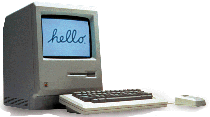History of computer design: Introduction
4-frogdesign || 5-Corporate focus || Conclusion || Bibliography & links
![]()
![]()
In 1984, Apple Computer introduced
Macintosh, a computer intended to be literally
revolutionary. It presented dramatic technological
innovations to the public in a physical design that
reflected a break with the past and forced a new approach
to technology onto its users.
Over the next few years, the presentation of this technology
gradually became subsumed by customer and marketing demands.
The personal vision of a small team was diluted into
products which became differentiated less by concept than by
technical power and superficial detail. The form of Apple's
desktop computers became distinct through the consistent use
of a design language rather than by physical features that
explicitly guided their use. This
design language, a set of
superficial details that were related to function but did
not dictate it, also first appeared in 1984, but in
a version of the technologically less
advanced Apple II computer. Adaptation of this design
language to later, more conservative, products was the
direct result of a new corporate direction for Apple, both
in its internal structure and in its market focus. The
personal computing revolution expressed by Macintosh was
rendered more palatable to a changing audience by fulfilling
expectations that were then reinforced, contributing to the
development of a standard physical form for the computer.
technology onto its users.
Over the next few years, the presentation of this technology
gradually became subsumed by customer and marketing demands.
The personal vision of a small team was diluted into
products which became differentiated less by concept than by
technical power and superficial detail. The form of Apple's
desktop computers became distinct through the consistent use
of a design language rather than by physical features that
explicitly guided their use. This
design language, a set of
superficial details that were related to function but did
not dictate it, also first appeared in 1984, but in
a version of the technologically less
advanced Apple II computer. Adaptation of this design
language to later, more conservative, products was the
direct result of a new corporate direction for Apple, both
in its internal structure and in its market focus. The
personal computing revolution expressed by Macintosh was
rendered more palatable to a changing audience by fulfilling
expectations that were then reinforced, contributing to the
development of a standard physical form for the computer.
The physical design of Apple's personal computers in the years preceding and following the introduction of the original Macintosh expresses monumental changes in what Steven Lubar has called "'machine politics': the ways in which machines modulate, influence, and intermediate the interactions of groups" (Lubar, 198). Between 1977 and 1991, microcomputers gradually assumed a large place in daily lives, evolving from a novelty, hobby item into a routinely used tool. Appeal to technological determinism to explain this evolution belittles the importance of "machine politics;" the appearance and function of personal computers were shaped together not in any simple way by technical improvements, but by two frequently conflicting groups, the designers and the users. The history of Apple computer reveals the tension between a design centered on guiding the users' relationship to computing and the expectations of the users themselves.
Home || Introduction || Historiography || 1-Cottage industry || 2-Emerging standards || 3-Macintosh
4-frogdesign || 5-Corporate focus || Conclusion || Bibliography & links







.jpg)








